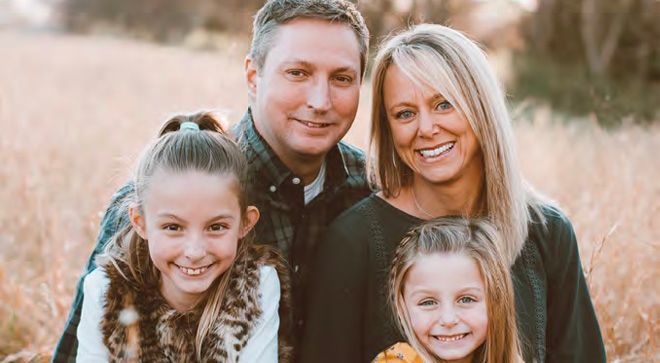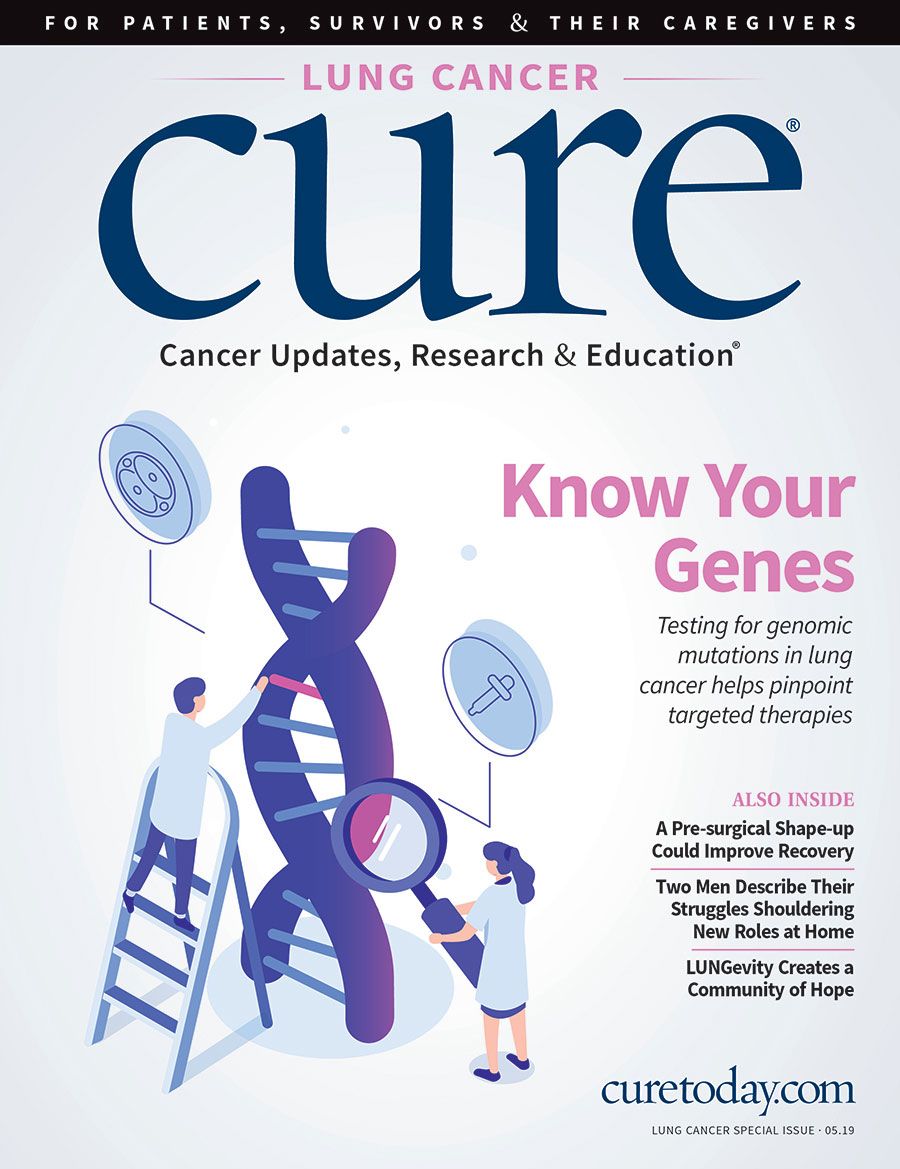Publication
Article
CURE
Know Your Genes: Testing for Genomic Mutations in Lung Cancer
Author(s):
Testing for genomic mutations in lung cancer helps pinpoint targeted therapies.
Amanda Nerstad was 39 years old and a busy working mother of two young children when she learned she had metastatic lung cancer in 2016. She was given between two weeks and nine months to live. Her oncologist at the University of Tennessee Medical Center wanted to send out her tumor biopsy for genomic testing but informed her that the process would take up to two weeks. Nerstad was concerned, especially because her cancer was so aggressive, but agreed to the testing. “It was the longest two weeks of my life,” she says. “But once it came back, my doctor said it was great news. My tumor was ALK positive.”
That meant that Nerstad’s tumor, which was non-small cell lung cancer (NSCLC), tested positive for ALK rearrangement, a gene abnormality that is found in about 5 percent of NSCLC cases and causes the abnormal growth and spread of cancer cells. Only a small percentage of NSCLC tumors have this characteristic, but this is only one of several different gene abnormalities which, like in Nerstad’s case, can respond well to drugs that are designed to block the protein/enzyme made by the mutated gene.
Nerstad was initially put on Xalkori (crizotinib), a twice-daily pill that inhibits ALK. It kept her cancer stable, but it also made her nauseated and suppressed her white blood cells. After six months on Xalkori, she consulted with her oncologist at The University of Texas MD Anderson Cancer Center in Houston, who recommended switching her to another ALK-inhibiting pill, Alecensa (alectinib), because of her abnormal lab results. Her scans have shown complete metabolic response since being placed on Alecensa, which was approved by the Food and Drug Administration (FDA) in late 2017 for the first-line treatment of patients with metastatic ALK-positive NSCLC.

GARY and AMANDA NERSTAD, with their daughters, ISABELLA, left, and GRETA.
“Right now, I’m winning,” says Nerstad, who lives in Knoxville, Tennessee, and works as a flight attendant. “Without genetic testing, I don’t think I would be here.” Aside from a bit of achiness in her feet in the morning and some sun sensitivity, she adds, she doesn’t have any side effects from the Alecensa.
Gene testing is becoming more common in the diagnosis and treatment of NSCLC. Many oncologists believe such testing should be universal due to the discovery of gene mutations and other alterations that drive the disease and, subsequently, the development of more than a dozen drugs that target those abnormalities. By looking for gene abnormalities in tumor samples and sometimes in blood, oncologists can create tailored treatment regimens based on the characteristics of patients’ cancer that are most likely to respond to these new treatments.
“It changes everything for the patient. It essentially makes the disease like a chronic illness,” says Anne Tsao, M.D., a professor in the department of thoracic/head and neck medical oncology at MD Anderson, “and a lot of patients have a good quality of life.”
NSCLC accounts for 80 to 85 percent of all lung cancer diagnoses, and symptoms include a persistent cough, shortness of breath and chest pain. The problem is, these symptoms usually don’t appear until the cancer has reached an advanced stage, making it difficult to diagnose the disease in its earliest stages, when it’s easiest to treat. Although people who smoke face a higher risk of developing lung cancer, the disease often occurs in nonsmokers, too.
An estimated 60 percent of patients with lung adenocarcinoma, a common NSCLC tumor type, have mutations that are believed to be responsible for their cancers, according to Memorial Sloan Kettering Cancer Center in New York City. Some of the NSCLC mutations that are currently targetable with drugs are EGFR, ALK, NTRK, BRAF and ROS1. The medicines all fall into a class known as kinase inhibitors, meaning they block a type of enzyme that controls cancer cell division, growth and survival.
Many of these drugs have greatly improved the survival outlook for patients with NSCLC. For example, the clinical trial that led to the approval of Alecensa showed that in previously untreated patients with metastatic disease, the medication allowed patients to survive 25.7 months without disease worsening or dying — more than double that of patients who took Xalkori, and three times longer than patients treated with chemotherapy.
NEXT-GENERATION SEQUENCING
Several types of tests can be used to detect tumor mutations in patients with NSCLC. One is next-generation sequencing (NGS), which involves using a single test to detect multiple gene alterations in a tumor biopsy sample. Another option is to test for mutations one at a time, starting with EGFR, which is the most prevalent; waiting for the result; and then testing for another mutation if the patient is EGFR negative.
Many oncologists opt for the one-at-a-time option because they perceive it to be less costly than NGS, says Nathan Pennell, M.D., Ph.D., an associate professor of medicine at Cleveland Clinic in Ohio. But a 2018 study led by Pennell found that NGS is associated with significant cost and time savings. It takes about two weeks to get results back from NGS testing — about half the time it takes for sequential test results. Using a decision-analysis model, Pennell and his co-authors estimated that NGS would save insurance providers up to $250,000 over other testing methods.
“I absolutely think it’s reasonable for patients to ask for NGS,” Pennell says. Some hospitals, including Cleveland Clinic, use their own panel tests that include several of the most common mutations in one test. That’s also acceptable, Pennell says, provided results can be returned in two weeks or less. Obtaining insurance approval for NGS or broad-panel testing can be a challenge, he adds, but oncologists are accustomed to having those conversations with providers of health care plans and most will fight to secure the necessary coverage.
Another testing method that’s gaining ground is the liquid biopsy, which involves searching for tumor DNA that’s been cast off into the bloodstream. One advantage of blood testing is that it’s fast, so patients can often get their results and start treatment sooner than they would if they had to wait for a biopsy to be taken. Also, liquid biopsies can be repeated throughout treatment to test for new mutations that drugs might be able to target.
The challenge is that tumor DNA doesn’t always end up in the bloodstream. That’s one reason Tsao prefers to do both types of testing simultaneously. “Since you can miss a diagnosis with sampling of either tumor or blood, I think both are really crucial to check for a brand-new diagnosis. The amount of time it takes to go through a biopsy and get the next-generation sequencing done can be three to four weeks, which is stressful for the patient,” she says.
In a study released in February, a liquid biopsy technology made by Guardant Health correctly identified EGFR, ALK, BRAF and ROS1 alterations in 77 out of 282 patients — and it did so in nine days versus 15 days for tissue-based testing.
EMERGING MUTATIONS
Several emerging gene abnormalities found in NSCLC can be targeted with drugs that are either on the market to treat other cancers or are being studied. They include HER2, RET, MET and PIK3CA. Although the drugs are not yet FDA approved to treat NSCLC, clinical trials investigating their potential in the disease are underway and enrolling new patients.
As important as targeted treatments have been in NSCLC, virtually all patients eventually become resistant to the drugs, a problem that has inspired ongoing research into gene mutations that drive the disease as it progresses. That research has already produced important advances.

For example, about half of patients with EGFR mutations who are treated with first generation drugs develop a second mutation called EGFR T790M. In 2017, the FDA approved Tagrisso (osimertinib) to treat those patients, based on a clinical trial in which the overall response rate — tumors shrunk or disappeared — to the drug was 65 percent compared with 29 percent for patients who received chemotherapy.
In 2018, the FDA added an approval for Tagrisso for the treatment of newly diagnosed patients with specific EGFR mutations called exon 19 deletion or exon 21 L858R. In a clinical trial comparing the drug to a standard regimen of older EGFR-inhibiting medicines, the progression-free survival rate — meaning a patient’s disease did not worsen — was significantly longer than it was for standard EGFR blockers.
Combination treatments in EGFR-mutated NSCLC might also result in longer-lasting treatment success for patients, says David Carbone, M.D., Ph.D., Barbara J. Bonner Chair in Lung Cancer Research and medical oncologist at The Ohio State University James Comprehensive Cancer Center — Arthur G. James Cancer Hospital and Richard J. Solove Research Institute. When cancers are treated with these drugs, responses are rapid (occurring within a few weeks), but the drugs fail to eliminate all of the cancer and eventually these persisting cells become resistant to the drug and begin to regrow. Carbone has been studying EGFR-mutated cancer cells that persist in spite of targeted treatments. He discovered that a protein called beta-catenin protects these persisting cancer cells from dying and that blocking this second protein in animal models improves the duration of response and survival to EGFR inhibitors. He’s now hoping to put together a clinical trial of a beta-catenin inhibitor with an EGFR blocker.
Immunotherapy drugs that enable the immune system to recognize and attack cancer are also being tested in combination with other approaches, Carbone says, including in patients who don’t have easily targetable mutations. One particularly encouraging result came from a clinical trial that combined two chemotherapy treatments with two targeted therapies, Tecentriq (atezolizumab) and Avastin (bevacizumab), in patients with stage 4 NSCLC. Tecentriq blocks the checkpoint PD-L1, which normally prevents the immune system from recognizing and attacking cancer. Avastin inhibits VEGF, a protein that’s essential for forming the blood vessels that feed tumors and allow them to grow but is also known to modulate the immune system.
In results presented in 2018, the four-drug combination reduced the risk of death by 22 percent over a combination of Avastin and chemotherapy. The FDA has approved the four-drug treatment for first-line treatment of patients with NSCLC without EGFR or ALK alterations, but the trial also demonstrated an overall survival benefit, even greater than the general population, in patients with EGFR or ALK alterations who had previously been treated with targeted drugs. “That shows that combining immunotherapy with anti-VEGF could be another way of improving the immune responses to these tumors with these gene mutations,” Carbone says.
Carbone is also encouraged by the newer targeted treatments’ ability to attack NSCLC that has metastasized to the brain. In a clinical trial of the ALK-targeting drug Alecensa, patients with brain metastases had an overall response rate in the brain of 81 percent; for 59 percent of those patients, the response lasted more than a year. Alecensa has also been shown to reduce the risk of ALK-positive NSCLC spreading to the brain.
In a clinical trial of LOXO-292, an oral investigative treatment being developed for patients with NSCLC who have a genetic abnormality called RET fusion, all patients with measurable brain metastases responded to the drug. LOXO-292 was granted breakthrough therapy designation by the FDA in September 2018, which could help speed its path to market.
“Some of these new targeted drugs have a much better ability to penetrate the brain, so we’re seeing these very significant responses in patients with brain metastases that we’ve never seen before,” Carbone says. “That’s extremely exciting. Many of these people never need whole-brain radiation.” That treatment can be effective but also can cause side effects like forgetfulness, he adds.
The proliferation of targeted treatments is benefiting patients like Patty Watkins, who in January 2014 received a diagnosis of NSCLC, which had metastasized to the area around her heart. Her tumor tested positive for a mutation in the gene ROS1. She was treated with two months of chemotherapy, after which she entered a clinical trial of Xalkori — FDA approval of the medication to treat ROS1- positive NSCLC occurred in 2016. But after 21 months, the cancer spread to her brain.

PATTY WATKINS, center, won tickets to Super Bowl 53 through the Chris Draft Family Foundation. Ahead of the game, she was interviewed by CNN news anchor CHRISTI PAUL, left, along with former NFL linebacker CHRIS DRAFT, right.
In 2016, Watkins was accepted on a compassionate-use basis into a clinical trial of Lorbrena (lorlatinib), a drug that is approved to treat ALK-positive NSCLC and is now being tested in patients with the ROS1 mutation.
Her cancer disappeared, and she remains on the drug today. Her only side effects are a bit of weight gain plus neuropathy in her hands and feet, and she takes a statin to hold down the elevated cholesterol caused by the drug.
Watkins considers herself lucky to have her cancer diagnosed at a time when so many targeted drugs are being developed and tested. “My doctors told me I had a couple of days to live and that I should bring my kids home from college,” recalls Watkins, 62, who lives in Atlanta.
“Thanks to research I’m a five-year survivor ready to rock my first grandchild.”





